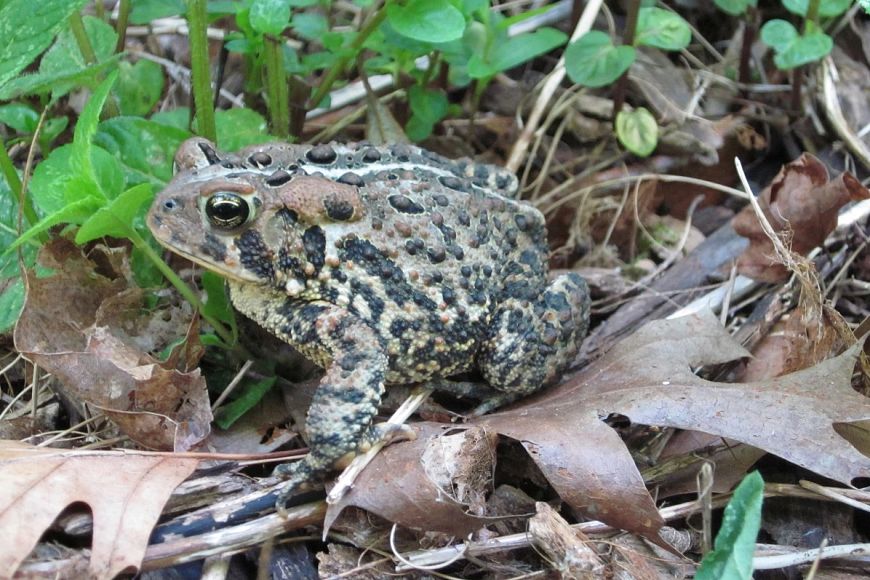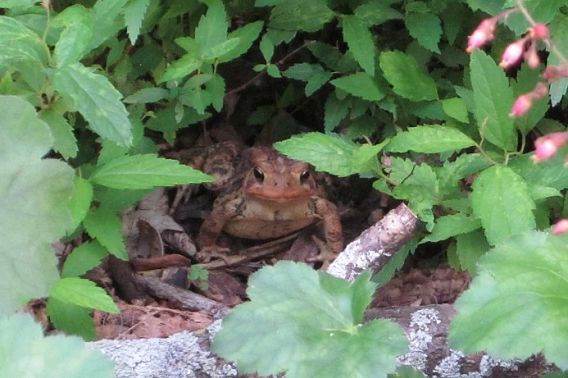SPRINGTIME FOR TOADS
Marvels of the garden re-emerge as weather warms
Story and photos by Christel Maass
 American toad
American toadI hear the American toads trilling in the parkway creek across from our house in the spring. They’ve come out from their frozen winter slumber.
The toads have spent the past several months burrowed deep in the soil under the leaf litter. When the weather finally warms, I encounter them all around my yard as I walk from garden to garden.
They often bound from the grass at the garden’s edge, escaping my footfall as I bear close. If I don’t actually catch sight of them, movement amid the plantings makes their presence known.
When I do spot them, I crouch to examine their size and colors, and to determine whether it’s a toad I’ve spotted before.
In recent years, we’ve welcomed so many of them. To me, they indicate we have a healthy habitat, which is what we strive to provide for wildlife in our going-native and pesticide-free suburban yard.
These toads, I’ve discovered, are uniquely and wonderfully diverse. Their skin colors range from beautiful shades of tan, light and dark browns and greys to some with deep reddish touches and white details.
One of the more unusual-hued toads was burnt orange and another olive beige, both with tones blending into their surroundings — the former against gravel aside the house and the latter similar in color to dried plant stems left to decompose in the garden.
The toads have spots and stripes and bold patterns. And they have personality — some fearful, some determined, others watchful and defiant.
 Toads show up just about everywhere in the author's backyard garden and are especially fond of cool, moist spots when heat begins to build.
Toads show up just about everywhere in the author's backyard garden and are especially fond of cool, moist spots when heat begins to build.PLACES, EVERYONE
The toads appear to have their own territories and hiding places. Last year, one sheltered amid the large rocks at the edge of our sunny patio, where he appeared to suffer on hot days.
Others reside between logs I’ve incorporated into my garden borders, by the dripping rain barrel and in the cool moistness at the ends of downspouts. Another prefers the wet driveway culvert.
My friend’s mother guarantees you’ll find a toad in her strawberry patch, and that is usually the case in our plot, too. They are also partial to our herb garden, particularly the mint patch.
Toads can be entertaining. One evening around sunset, when toads are more active, I did a double take when I discovered a toad waiting for prey in the depression between the ears of an ornamental rabbit. The toad returned to that hunting perch at the edge of a woodland garden on subsequent nights.
Searching carefully, I find toads hunkered down, hidden amid the decomposing leaves and organic matter. I notice shallow depressions in my gardens where I’ve seeded and watered, and I suspect a toad has been enjoying the cooling moistness.
I’ve tucked water sources, including old pasta bowls and a chipped pie dish, into my gardens for wildlife. On oppressively hot days, I find toads soaking in them — truly a treat to behold.
Plant leaves provide an umbrella of protection from the sun’s rays over these bathing basins, and I’m mindful to leave this cover intact. One afternoon, a toad hopped across our patio to sit in the damp saucer under a flowerpot, so now I make sure there’s soaking space there, too.
I found another toad would wait for prey after dark by sitting motionless in a puddle on the driveway, giving me good reason not to sweep that rainwater away in the future.
NATURAL PEST CONTROL
I’m particularly glad to find toads in my vegetable garden, where the slug damage to my kale plants has noticeably lessened thanks to the toads’ diet. These garden helpers are a natural pest control squad.
Stopping to observe, I’ve seen a tongue flash to catch a small insect I barely noticed and have caught sight of toads devouring an earthworm.
Furthering my efforts to welcome toads, I’ve incorporated clay flowerpots and stoneware jugs, positioned sideways and worked partially down in the soil, for potential toad abodes in the landscape as well.
Toads! I marvel.
These amphibians endure temperature extremes that keep most humans indoors during our brutal winters and blazing summers. They’ve made me more appreciative of the wonders and diversity of nature.
When fall rolls around again, I’ll rake the leaves into our gardens and let the plant cuttings decay on site, providing habitat for another season.
Christel Maass gardens and welcomes wildlife to her yard in Fox Point.
INFORMATION
The American toad is a common species throughout Wisconsin. For details, including a short video, go to American toad. To learn more about citizen-based monitoring of the state’s frogs and toads and how to get involved, check out the Wisconsin Frog and Toad Survey.

